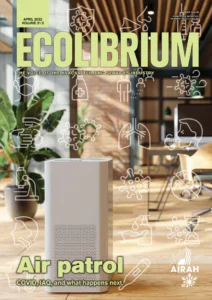An all-electric future

What does the changing nature of our energy mix mean for HVAC&R engineers?
As we wrestle with the various issues around climate change, one trend has become clear. We are now on an inevitable drive for an all-electric HVAC&R future.
Our industry will require better skills in electrical engineering aspects associated with mechanical services. And there will be a greater demand for HVAC&R engineers to become more competent with electrical services design and specification.
Traditionally, many HVAC&R engineers have depended on their electrical engineering colleagues to provide support. Moving forward, HVAC&R engineers will be expected to have these skills.
So, what is a mech-elec future, and what does it look like? Discussing this with one of our respected members, Lasath Lecamwasam, F.AIRAH, he thinks that if words such as, “discrimination”, “diversity”, “segregation”, “maximum demand”, “fault level”, “earth-loop impedance”, “arc flash”, “fibrillation” and the like are a puzzle to you, then it is time to unravel the secrets of electrical engineering for our members.
“Due to misunderstandings between the disciplines, sometimes the integration between the two systems is sub-optimal,” Lecamwasam says.
“And apart from potential safety issues, this could lead to additional costs to the client for unnecessary infrastructure, and additional strain on utility companies to provide larger electricity sub-stations and network augmentation.”
Focus areas
These issues have already been raised by several of our members, who have shared some examples of what our industry’s future education needs will be in this area. These include:
- An appreciation of AS/NZS 3000 (wiring rules) with regards to electrical safety. There is a lot of misunderstanding in the industry, even among established practitioners, who sometimes do not realise the demarcation between the rules that apply to the fixed installation versus the equipment itself. They are complementary but different sets of rules, and include EMC-RFI and harmonics.
- Understanding the relationship between thermal energy, electrical power, Amps drawn, maximum demand, diversity factors, etc. Without the need to convert our members into fully-fledged electrical design engineers, HVAC&R engineers should have sufficient confidence and knowledge to effectively communicate and coordinate with electrical engineers and contractors.
- A better understanding of “big picture” issues including diversity factors such as duty stand-by, lead lag, and the like; load management; load shedding; contributions from solar PV and the like. This should reduce misunderstandings between mechanical and electrical engineers, and the potential for conservative overdesign in our industry, which can have repercussions all the way from money being wasted on bigger‑than‑necessary switchboards, utility sub‑stations and even power stations.
Next steps
To facilitate the next steps, I would like to hear from our members on these issues and how to best address this potential skills gap. In particular, I see the potential need for development of:
- A series of peer-reviewed articles in Ecolibrium
- Production of a Design Application Guide for electrical services for HVAC&R
- Development of a detailed certificate or diploma program.
Because electrical aspects of HVAC&R are also very important to installers of equipment, I hope we will get responses from our valued members who are installation technicians, contractors, and representatives from TAFEs and other training providers.

This article appears in Ecolibrium’s April 2022 edition
View the archive of previous editions
Latest edition
See everything from the latest edition of Ecolibrium, AIRAH’s official journal.





